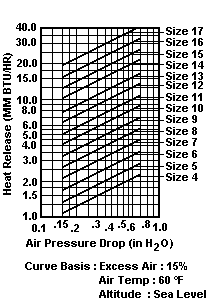Burner Types And Selection
Burners for fired heaters can be generally divided into two categories, natural draft and forced draft. The natural draft type burner requires less pressure differential to provide the required air for combustion then the forced draft burner. Air pressure differential, or pressure drop, across a natural draft burner would normally fall in the 0.1 to 1.0 in H2O range, where the forced draft burner would normally require 0.3 to 4.0 in H2O. Burner combustion air can also be induced by the fuel gas flowing through a venturi section. Also burners have different air registers for primary and secondary air intake. The air may be delivered to the registers by an air plenum.
In addition to burners being classified by the draft requirements, they are also described by the fuel they burn such as oil or gas or combination. There are numerous fuels which may be burned including:
| Refinery Gas | Propane or Heavier Gas |
| Natural Gas | High Hydrogen Gas |
| Waste Gas | No. 2 Fuel Oil |
| No. 6 Fuel Oil | Other Liquids |
Burners may be of the low NOx which may incorporate staged air or fuel designs. These burner types have become almost standard in the developed world where environmental air standards demand the best combustion technology available.
Burners may be designed for mounting in the heater floor, side walls, or end walls. The burner tips can be designed for various shapes or flame patterns.
In conclusion, there is such a wide variety of types and configurations of burners available from the many manufacturers, that selecting a particular burner for a design requires that the designer work closely with the burner manufacturer to assure the correct selection. But, for many furnaces, the burner(s) can be selected and sized using the standard data provided in the manufacturer's catalog.
This data might consist of a graph similar to that shown below for a sizing standard burners for natural draft:
 |
Heat Release = Design Release * AirCorr * AltCorr * TempCorr Where, AirCorr = (1 + ExcessAir%/100)/1.15 AltCorr = 1 + (Altitude/1000)*0.02 TempCorr = ((Temp+460)/520)0.5 |
As an example of how this data may be used, we will set up the following data:
Natural draft, cylindrical fired heater :
Tube circle = 7.25 feet
Radiant height = 18.4 feet
Heat Release = 14.24 MM Btu/hr
Excess Air = 15%
Air temperature = 80 °F
Altitude = 1200 feet
Flue Gas Temperature = 1630 °F
Flue gas density, rg = .0183 lb/ft3
Ambient air density, ra = .0725 lb/ft3
So (per our equation in section 6 under Ducting Pressure Loss),
Draft available = (.0725-.0183)/5.2*18.4 = 0.192 inH2O
And we can calculate the heat release required,
AirCorr = (1 + 20/100)/1.15 = 1.043
AltCorr = 1 + (1200/1000)*0.02 = 1.024
TempCorr = ((80+460)/520)0.5 = 1.019
So,
Heat Release = 14.24 * 1.043 * 1.024 * 1.019 = 15.49 MM Btu/hr
Now to take care of all the things that can go wrong and for future possible changes, we multiply this by 1.25 to get a safety factor, or 19.4 MM Btu/hr required.
From the chart, a size 17 burner will work fine. Had the heater been larger in size, we would have probably used multiple burners to achieve more flexibility, even though one might provide necessary release.
Disclaimer:
The formulas and correlations presented herein are all in the public domain and are to be used only as a learning tool. Note that any product, process, or technology in this document may be the subject of other intellectual property rights reserved by sponsors or contributors to this site. This publication is provided as is, without any warranty of any kind, either expressed or implied, including, but not limited to, the implied warranties of fitness for a particular purpose, or non-infringement.
The formulas, correlations, and methods presented herein should not be considered as being recommended by or used by the sponsors of this site. The purpose of this site is educational and the methods may or may not be suitable for actual design of equipment. Only a fired heater design engineer is qualified to decide if a calculation or procedure is correct for an application.